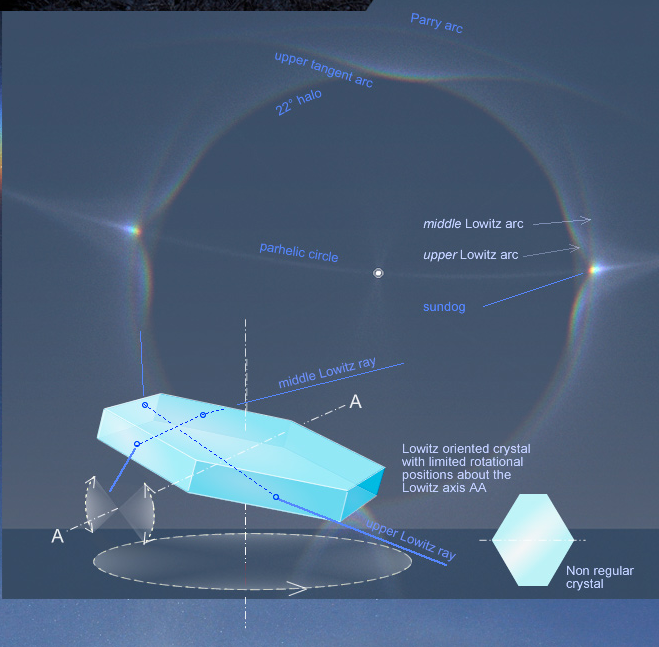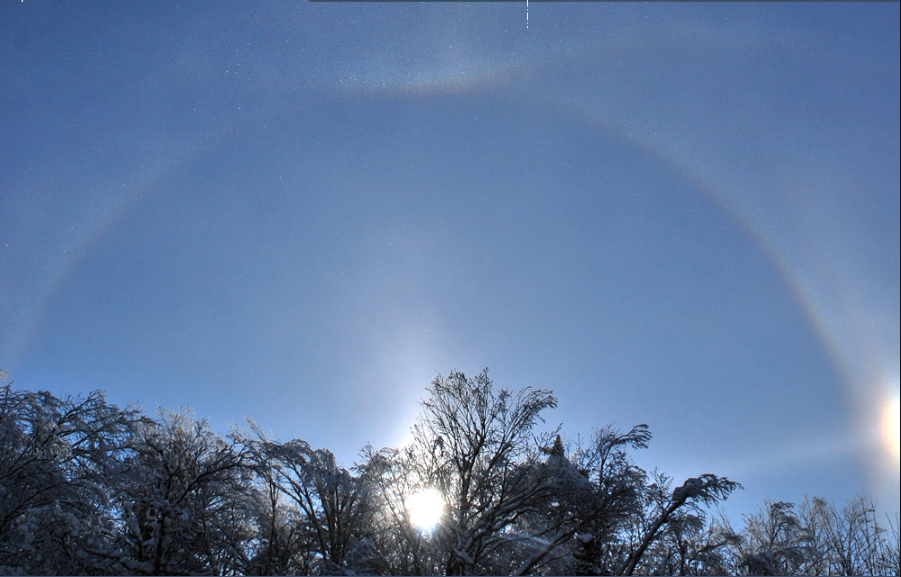Lowitz Middle Arc
Lowitz Middle Arc: A Rare Atmospheric Optical Phenomenon
The Lowitz Middle Arc is a captivating atmospheric optical phenomenon that has been intriguing scientists and photographers alike for centuries. First recorded in 1790 and later photographed in 1990, these arcs are still shrouded in mystery and continue to reveal their secrets to those who study them.
A Unique Manifestation of the Lowitz Arc
While Lowitz arcs are commonly described as extensions from a sundog towards the 22 degree halo, there is a less common manifestation known as the "middle" arc. This bright arc extends upward from the sundog and is distinctively separated from the 22 degree halo. In enhanced images, it can even reach the upper tangent and Parry arcs, adding to its enigmatic nature.
Understanding the Formation of Lowitz Arcs
Lowitz arcs are believed to arise from hexagonal prism crystals that exhibit various tilts about a horizontal axis passing through two opposite prism edges. Rays passing between prism faces inclined at 60 degrees to each other can take three routes relative to the axis. Two of these routes give rise to the "upper" and "lower" arcs, which extend from sundogs to meet the 22 degree halo. The third route, where the ray crosses the crystal roughly parallel to the rotation axis, generates the intriguing "middle" arc.
Simulating Lowitz Arcs
In order to gain a deeper understanding of the formation of Lowitz arcs, scientists have conducted simulations to study the appearance of these optical phenomena. By altering parameters such as the relative lengths of the crystal side faces, the extent of its tilt from horizontal, and its thickness, researchers have been able to observe how these factors influence the brightness, angular extent, variation in brightness along the length, and appearance near the sundog of each arc.
The Complex Nature of Lowitz Arcs
Despite extensive simulations and research, the complete understanding of Lowitz arcs remains elusive. The current model used to explain their formation may require further refinement or improvement. Scientists have found that while the simulations provide an acceptable fit to the observed phenomena, attempts to refine the parameters do not significantly enhance the accuracy of the model. Thus, the formation of Lowitz arcs continues to be a topic of ongoing investigation and scientific curiosity.
Capturing the Beauty of Lowitz Arcs
Photographers have been fortunate enough to capture the rare beauty of Lowitz arcs in their images. These stunning photographs showcase the intricate details and vibrant colors of this atmospheric optical phenomenon. Freelance photographer Judith Howcroft, for instance, managed to capture a rare Lowitz Middle Arc in diamond dust in Northern New Hampshire on the morning of January 22, 2010. Her photograph serves as a testament to the allure and enchantment of these elusive arcs.
Further Exploration and Discoveries Await
As scientists and photographers delve deeper into the study of atmospheric optics, more discoveries about Lowitz arcs and other phenomena are sure to emerge. The combination of advanced simulations, innovative research techniques, and a keen eye for capturing these optical wonders in photographs will undoubtedly contribute to our understanding and appreciation of the natural world around us.
In conclusion, the Lowitz Middle Arc is a remarkable atmospheric optical phenomenon that continues to fascinate and mystify. While its formation remains incompletely understood, scientists and photographers alike are captivated by its unique manifestation and intricate details. Through ongoing research and exploration, we can hope to unravel the secrets of this rare and beautiful phenomenon, shedding light on the wonders of our atmosphere.

Rare Lowitz Middle Arc ~ Captured in diamond dust by freelance photographer Judith Howcroft (Wilderness Light Photography) in Northern New Hampshire on the morning of January 22, 2010. ©Judith Howcroft, shown with permission
Lowitz arcs, first recorded in 1790 and first photographed some 200 years later, are rarely seen clearly and they still guard their secrets.
The arcs are mostly described as extensions from a sundog towards the 22 degree halo but that is only one of their aspects. Here we see a less usual manifestation – a bright ‘middle’ arc extending upward from the sundog and well separated from the 22 degree halo. In enhanced images it reaches the upper tangent and Parry arcs.
Lowitz arcs are thought to arise from hexagonal prism crystals (not necessarily thin plates) taking various tilts about a horizontal axis passing through two opposite prism edges. Rays passing between prism faces inclined 60° to each other have three routes relative to the axis. Two of them give the ‘upper’ and ‘lower’ arcs that extend from sundogs to meet the 22 degree halo. The third route where the ray crosses the crystal very roughly parallel the rotation axis generates the ‘middle’ arc.
In simulations we can tune the appearance of the three arcs by (1) changing the relative lengths of the crystal side faces, by (2) altering the extent of its tilt from horizontal and (3) by changing its thickness. Some aspects to look for are the way all these influence each arc's brightness, its angular extent, the variation in brightness along the length and the appearance near to the sundog.
The matching HaloSim ray tracing at right (sun 24° high) used quite thick plates, c/a=0.5, with their side faces next to the Lowitz axis twice the length of others. Tilts were restricted to a Gaussian distribution around zero with standard deviation 24°. The fit is not unique and other parameter combinations are possible. However, like other halos that we do not understand fully, the simulations are ‘OK’ but attempts to further refine the parameters do not greatly improve the fit. The arcs and how they are made are not fully understood and the model itself perhaps needs improvement.


Note: this article has been automatically converted from the old site and may not appear as intended. You can find the original article here.
Reference Atmospheric Optics
If you use any of the definitions, information, or data presented on Atmospheric Optics, please copy the link or reference below to properly credit us as the reference source. Thank you!
-
<a href="https://atoptics.co.uk/blog/lowitz-middle-arc/">Lowitz Middle Arc</a>
-
"Lowitz Middle Arc". Atmospheric Optics. Accessed on November 24, 2024. https://atoptics.co.uk/blog/lowitz-middle-arc/.
-
"Lowitz Middle Arc". Atmospheric Optics, https://atoptics.co.uk/blog/lowitz-middle-arc/. Accessed 24 November, 2024
-
Lowitz Middle Arc. Atmospheric Optics. Retrieved from https://atoptics.co.uk/blog/lowitz-middle-arc/.